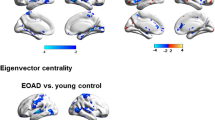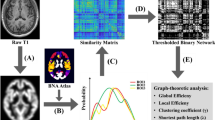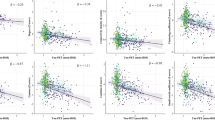Abstract
The physiological basis of resilience to age-associated and AD-typical neurodegenerative pathology is still not well understood. So far, the established resilience factor intelligence has been shown to be associated with white matter network global efficiency, a key constituent of which are highly connected hubs. However, hub properties have also been shown to be impaired in AD. Individual predisposition or vulnerability of hub properties may thus modulate the impact of pathology on cognitive outcome and form part of the physiological basis of resilience. 85 cognitively normal elderly subjects and patients with MCI with DWI, MRI and AV45-PET scans were included from ADNI. We reconstructed the global WM networks in each subject and characterized hub-properties of GM regions using graph theory by calculating regional betweenness centrality. Subsequently, we investigated whether regional GM volume (GMV) and structural WM connectivity (WMC) of more hub-like regions was more associated with resilience, quantified as cognitive performance independent of amyloid burden, tau and WM lesions. Subjects with higher resilience showed higher increased regional GMV and WMC in more hub-like compared to less hub-like GM-regions. Additionally, this association was in some instances further increased at elevated amounts of brain pathology. Higher GMV and WMC of more hub-like regions may contribute more to resilience compared to less hub-like regions, reflecting their increased importance to brain network efficiency, and may thus form part of the neurophysiological basis of resilience. Future studies should investigate the factors leading to higher GMV and WMC of hubs in non-demented elderly with higher resilience.




Similar content being viewed by others
References
Aiken, L. S., West, S. G., & Reno, R. R. (1991). Multiple regression: Testing and interpreting interactions. SAGE.
Albert, R., Jeong, H., & Barabási, A.-L. (2000). Error and attack tolerance of complex networks. Nature, 406(6794), 378–382. https://doi.org/10.1038/35019019.
Arenaza-Urquijo, E. M., Landeau, B., La Joie, R., Mevel, K., Mézenge, F., Perrotin, A., et al. (2013). Relationships between years of education and gray matter volume, metabolism and functional connectivity in healthy elders. NeuroImage, 83, 450–457. https://doi.org/10.1016/j.neuroimage.2013.06.053.
Ashburner, J., & Friston, K. J. (2000). Voxel-based morphometry—The methods. NeuroImage, 11(6), 805–821. https://doi.org/10.1006/nimg.2000.0582.
Bartrés-Faz, D., Solé-Padullés, C., Junqué, C., Rami, L., Bosch, B., Bargalló, N., Falcón, C., Sánchez-Valle, R., & Molinuevo, J. L. (2009). Interactions of cognitive reserve with regional brain anatomy and brain function during a working memory task in healthy elders. Biological Psychology, 80(2), 256–259. https://doi.org/10.1016/j.biopsycho.2008.10.005.
Barulli, D., & Stern, Y. (2013). Efficiency, capacity, compensation, maintenance, plasticity: Emerging concepts in cognitive reserve. Trends in Cognitive Sciences, 17(10), 502–509. https://doi.org/10.1016/j.tics.2013.08.012.
Bates, D., Mächler, M., Bolker, B., & Walker, S. (2014). Fitting Linear Mixed-Effects Models using lme4. Retrieved from https://arxiv.org/abs/1406.5823
Blennow, K., Vanmechelen, E., & Hampel, H. (2001). CSF total tau, Aβ42 and phosphorylated tau protein as biomarkers for Alzheimer’s disease. Molecular Neurobiology, 24(1), 87–098. https://doi.org/10.1385/MN:24:1-3:087.
Bortz, J. (2013). Statistik: Für Sozialwissenschaftler. Springer-Verlag.
Bullmore, E., & Sporns, O. (2012). The economy of brain network organization. Nature Reviews Neuroscience, 13(5), 336–349. https://doi.org/10.1038/nrn3214.
Carbo, E. W. S., Hillebrand, A., van Dellen, E., Tewarie, P., de Witt Hamer, P. C., Baayen, J. C., Klein, M., Geurts, J. J. G., Reijneveld, J. C., Stam, C. J., & Douw, L. (2017). Dynamic hub load predicts cognitive decline after resective neurosurgery. Scientific Reports, 7, 42117. https://doi.org/10.1038/srep42117.
Craik, F. I. M., Salthouse, T. A., & Salthouse, T. A. (2011, March 15). Intelligence, education, and the brain reserve hypothesis: Helen Christensen, Kaarin J. Anstey, Liana S. Leach, and Andrew J. Mackinnon. https://doi.org/10.4324/9780203837665-9.
Crane, P. K., Carle, A., Gibbons, L. E., Insel, P., Mackin, R. S., Gross, A., et al. (2012). Development and assessment of a composite score for memory in the Alzheimer’s Disease Neuroimaging Initiative (ADNI). Brain Imaging and Behavior, 6(4), 502–516. https://doi.org/10.1007/s11682-012-9186-z.
Crossley, N. A., Mechelli, A., Scott, J., Carletti, F., Fox, P. T., Mcguire, P., & Bullmore, E. T. (2014). The hubs of the human connectome are generally implicated in the anatomy of brain disorders. Brain, 137(8), 2382–2395. https://doi.org/10.1093/brain/awu132.
Deary, I. J., Penke, L., & Johnson, W. (2010). The neuroscience of human intelligence differences. Nature Reviews Neuroscience, 11(3), 201–211. https://doi.org/10.1038/nrn2793.
DeCarli, C., Fletcher, E., Ramey, V., Harvey, D., & Jagust, W. J. (2005). Anatomical mapping of white matter hyperintensities (WMH): Exploring the relationships between periventricular WMH, deep WMH, and total WMH burden. Stroke, 36(1), 50–55. https://doi.org/10.1161/01.STR.0000150668.58689.f2.
Filippi, M., Heuvel, M. P. van den, Fornito, A., He, Y., Pol, H. E. H., Agosta, F., … Rocca, M. A. (2013). Assessment of system dysfunction in the brain through MRI-based connectomics. The Lancet Neurology, 12(12), 1189–1199. https://doi.org/10.1016/S1474-4422(13)70144-3.
Fischer, F. U., Wolf, D., Scheurich, A., & Fellgiebel, A. (2014). Association of Structural Global Brain Network Properties with intelligence in Normal aging. PLoS One, 9(1), e86258. https://doi.org/10.1371/journal.pone.0086258.
Fischer, F. U., Wolf, D., Scheurich, A., & Fellgiebel, A. (2015). Altered whole-brain white matter networks in preclinical Alzheimer’s disease. NeuroImage: Clinical, 8, 660–666. https://doi.org/10.1016/j.nicl.2015.06.007.
Fletcher, E., Singh, B., Harvey, D., Carmichael, O., & DeCarli, C. (2012). Adaptive image segmentation for robust measurement of longitudinal brain tissue change. In 2012 Annual International Conference of the IEEE Engineering in Medicine and Biology Society (pp. 5319–5322). https://doi.org/10.1109/EMBC.2012.6347195.
Fornito, A., Zalesky, A., & Breakspear, M. (2015). The connectomics of brain disorders. Nature Reviews Neuroscience, 16(3), 159–172. https://doi.org/10.1038/nrn3901.
Gibbons, L. E., Carle, A. C., Mackin, R. S., Harvey, D., Mukherjee, S., Insel, P., … Initiative, for the A. D. N. (2012). A composite score for executive functioning, validated in Alzheimer’s Disease Neuroimaging Initiative (ADNI) participants with baseline mild cognitive impairment. Brain Imaging and Behavior, 6(4), 517–527. https://doi.org/10.1007/s11682-012-9176-1.
Hagmann, P., Kurant, M., Gigandet, X., Thiran, P., Wedeen, V. J., Meuli, R., & Thiran, J.-P. (2007). Mapping human whole-brain structural networks with diffusion MRI. PLoS One, 2(7), e597. https://doi.org/10.1371/journal.pone.0000597.
Holm, S. (1979). A simple sequentially Rejective multiple test procedure. Scandinavian Journal of Statistics, 6(2), 65–70.
Jack, C. R., Knopman, D. S., Jagust, W. J., Petersen, R. C., Weiner, M. W., Aisen, P. S., … Trojanowski, J. Q. (2013). Tracking pathophysiological processes in Alzheimer’s disease: An updated hypothetical model of dynamic biomarkers. The Lancet Neurology, 12(2), 207–216. https://doi.org/10.1016/S1474-4422(12)70291-0.
Koller, M. (2016). Robustlmm: An R package for robust estimation of linear mixed-effects models. Journal of Statistical Software. https://doi.org/10.18637/jss.v075.i06.
Li, Y., Liu, Y., Li, J., Qin, W., Li, K., Yu, C., & Jiang, T. (2009). Brain anatomical network and intelligence. PLoS Computational Biology, 5(5), e1000395. https://doi.org/10.1371/journal.pcbi.1000395.
Liang, X., Zou, Q., He, Y., & Yang, Y. (2013). Coupling of functional connectivity and regional cerebral blood flow reveals a physiological basis for network hubs of the human brain. Proceedings of the National Academy of Sciences, 110(5), 1929–1934. https://doi.org/10.1073/pnas.1214900110.
Lo, C.-Y., Wang, P.-N., Chou, K.-H., Wang, J., He, Y., & Lin, C.-P. (2010). Diffusion tensor Tractography reveals abnormal topological Organization in Structural Cortical Networks in Alzheimer’s disease. Journal of Neuroscience, 30(50), 16876–16885. https://doi.org/10.1523/JNEUROSCI.4136-10.2010.
Paradis, E., Claude, J., & Strimmer, K. (2004). APE: Analyses of Phylogenetics and evolution in R language. Bioinformatics (Oxford, England), 20(2), 289–290.
Raj, A., LoCastro, E., Kuceyeski, A., Tosun, D., Relkin, N., & Weiner, M. (2015). Network diffusion model of progression predicts longitudinal patterns of atrophy and metabolism in Alzheimer’s disease. Cell Reports, 10(3), 359–369. https://doi.org/10.1016/j.celrep.2014.12.034.
Reuter-Lorenz, P. A., & Park, D. C. (2014). How does it STAC up? Revisiting the scaffolding theory of aging and cognition. Neuropsychology Review, 24(3), 355–370. https://doi.org/10.1007/s11065-014-9270-9.
Rohde, G. K., Barnett, A. S., Basser, P. J., Marenco, S., & Pierpaoli, C. (2004). Comprehensive approach for correction of motion and distortion in diffusion-weighted MRI. Magnetic Resonance in Medicine, 51(1), 103–114. https://doi.org/10.1002/mrm.10677.
Rosen, W. G., Mohs, R. C., & Davis, K. L. (1984). A new rating scale for Alzheimer’s disease. American Journal of Psychiatry, 141(11), 1356–1364. https://doi.org/10.1176/ajp.141.11.1356.
Shaw, L. M., Vanderstichele, H., Knapik-Czajka, M., Clark, C. M., Aisen, P. S., Petersen, R. C., … Trojanowski, J. Q. (2009). Cerebrospinal fluid biomarker signature in Alzheimer’s disease neuroimaging initiative subjects. Annals of Neurology, 65(4), 403–413. https://doi.org/10.1002/ana.21610.
Smith, R. E., Tournier, J. D., Calamante, F., & Connelly, A. (2012). Anatomically-constrained tractography: Improved diffusion MRI streamlines tractography through effective use of anatomical information. NeuroImage, 62(3), 1924–1938. https://doi.org/10.1016/j.neuroimage.2012.06.005.
Stargardt, A., Swaab, D. F., & Bossers, K. (2015). The storm before the quiet: Neuronal hyperactivity and Aβ in the presymptomatic stages of Alzheimer’s disease. Neurobiology of Aging, 36(1), 1–11. https://doi.org/10.1016/j.neurobiolaging.2014.08.014.
Stern, Y. (2012). Cognitive reserve in ageing and Alzheimer’s disease. The Lancet Neurology, 11(11), 1006–1012. https://doi.org/10.1016/S1474-4422(12)70191-6.
Teipel, S. J., Meindl, T., Wagner, M., Kohl, T., Bürger, K., Reiser, M. F., Herpertz, S., Möller, H. J., & Hampel, H. (2009). White matter microstructure in relation to education in aging and Alzheimer’s disease 1. Journal of Alzheimer's Disease, 17(3), 571–583. https://doi.org/10.3233/JAD-2009-1077.
Todorov, V., & Filzmoser, P. (2009). An object-oriented framework for robust multivariate analysis. Journal of Statistical Software. https://doi.org/10.18637/jss.v032.i03.
Tomasi, D., Wang, G.-J., & Volkow, N. D. (2013). Energetic cost of brain functional connectivity. Proceedings of the National Academy of Sciences, 110(33), 13642–13647. https://doi.org/10.1073/pnas.1303346110.
van den Heuvel, M. P., & Sporns, O. (2013). Network hubs in the human brain. Trends in Cognitive Sciences, 17(12), 683–696. https://doi.org/10.1016/j.tics.2013.09.012.
van den Heuvel, D. M. J., ten Dam, V. H., de Craen, A. J. M., Admiraal-Behloul, F., Olofsen, H., Bollen, E. L. E. M., et al. (2006). Increase in periventricular white matter hyperintensities parallels decline in mental processing speed in a non-demented elderly population. Journal of Neurology, Neurosurgery & Psychiatry, 77(2), 149–153. https://doi.org/10.1136/jnnp.2005.070193.
Watts, D. J., & Strogatz, S. H. (1998). Collective dynamics of ‘small-world’ networks. Nature, 393(6684), 440–442. https://doi.org/10.1038/30918.
Wolf, D., Fischer, F. U., & Fellgiebel, A. (2018). A methodological approach to studying resilience mechanisms: Demonstration of utility in age and Alzheimer’s disease-related brain pathology. Brain Imaging and Behavior, 1–10. https://doi.org/10.1007/s11682-018-9870-8.
Wook Yoo, S., Han, C. E., Shin, J. S., Won Seo, S., Na, D. L., Kaiser, M., Jeong, Y., & Seong, J.-K. (2015). A network flow-based analysis of cognitive Reserve in Normal Ageing and Alzheimer’s disease. Scientific Reports, 5, 10057. https://doi.org/10.1038/srep10057.
Zamora-López, G., Zhou, C., & Kurths, J. (2010). Cortical hubs form a module for multisensory integration on top of the hierarchy of cortical networks. Frontiers in Neuroinformatics, 4. https://doi.org/10.3389/neuro.11.001.2010.
Acknowledgements
Data collection and sharing for this project was funded by the Alzheimer’s Disease Neuroimaging Initiative (ADNI) (National Institutes of Health Grant U01 AG024904) and DOD ADNI (Department of Defense award number W81XWH-12-2-0012). ADNI is funded by the National Institute on Aging, the National Institute of Biomedical Imaging and Bioengineering, and through generous contributions from the following: AbbVie, Alzheimer’s Association; Alzheimer’s Drug Discovery Foundation; Araclon Biotech; BioClinica, Inc.; Biogen; Bristol-Myers Squibb Company; CereSpir, Inc.; Cogstate; Eisai Inc.; Elan Pharmaceuticals, Inc.; Eli Lilly and Company; EuroImmun; F. Hoffmann-La Roche Ltd. and its affiliated company Genentech, Inc.; Fujirebio; GE Healthcare; IXICO Ltd.; Janssen Alzheimer Immunotherapy Research & Development, LLC.; Johnson & Johnson Pharmaceutical Research & Development LLC.; Lumosity; Lundbeck; Merck & Co., Inc.; Meso Scale Diagnostics, LLC.; NeuroRx Research; Neurotrack Technologies; Novartis Pharmaceuticals Corporation; Pfizer Inc.; Piramal Imaging; Servier; Takeda Pharmaceutical Company; and Transition Therapeutics. The Canadian Institutes of Health Research is providing funds to support ADNI clinical sites in Canada. Private sector contributions are facilitated by the Foundation for the National Institutes of Health (www.fnih.org). The grantee organization is the Northern California Institute for Research and Education, and the study is coordinated by the Alzheimer’s Therapeutic Research Institute at the University of Southern California. ADNI data are disseminated by the Laboratory for Neuro Imaging at the University of Southern California.
Author information
Authors and Affiliations
Consortia
Corresponding author
Ethics declarations
Conflict of interest
Author Florian U. Fischer, Author Dominik Wolf and Author Andreas Fellgiebel declare that they have no conflict of interest.
Informed consent
All procedures followed were in accordance with the ethical standards of the responsible committee on human experimentation (institutional and national) and with the Helsinki Declaration of 1975, and the applicable revisions at the time of the investigation. Informed consent was obtained from all patients for being included in the study.
Non-animal research
No animal studies were carried out by the authors for this article.
Additional information
Publisher’s note
Springer Nature remains neutral with regard to jurisdictional claims in published maps and institutional affiliations.
*Data used in preparation of this article were obtained from the Alzheimer’s Disease Neuroimaging Initiative (ADNI) database (adni.loni.usc.edu). As such, the investigators within the ADNI contributed to the design and implementation of ADNI and/or provided data but did not participate in analysis or writing of this report. A complete listing of ADNI investigators can be found at: http://adni.loni.usc.edu/wp-content/uploads/how_to_apply/ADNI_Acknowledgement_List.pdf
Electronic supplementary material
ESM 1
(DOCX 11 kb)
Rights and permissions
About this article
Cite this article
Fischer, F.U., Wolf, D., Fellgiebel, A. et al. Connectivity and morphology of hubs of the cerebral structural connectome are associated with brain resilience in AD- and age-related pathology. Brain Imaging and Behavior 13, 1650–1664 (2019). https://doi.org/10.1007/s11682-019-00090-y
Published:
Issue Date:
DOI: https://doi.org/10.1007/s11682-019-00090-y




